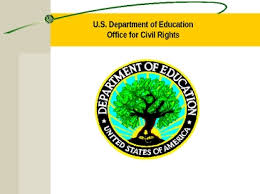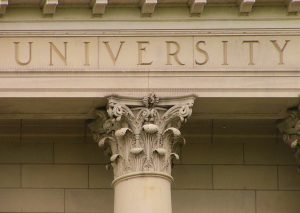OCR Issues Title IX Coordinator Resource Guide
May 4, 2015
 On April 24, the Department of Education’s Office for Civil Rights (“OCR”) issued new materials on Title IX. The materials include a Dear Colleague Letter to educational institutions, a letter to Title IX Coordinators and a Title IX resource guide. While the new documents are almost entirely a restatement of OCR’s previous pronouncements, there are a few noteworthy points. In the new materials, OCR focuses on the role of the Title IX Coordinator within an institution. Given the extent to which the materials reiterate OCR’s previous guidance and Q&A, it is unclear why OCR felt it necessary to create and release these new documents. One suspects that the attention is designed to increase the cultural authority of the Title IX Coordinator by stressing to the highest levels of institutional leadership the essential role that Coordinators play in Title IX compliance. OCR warns that many of the most egregious and harmful Title IX violations it has identified occurred when an institution failed to designate a Title IX Coordinator or failed to properly train and give an appropriate level of authority to its Coordinator. The new materials stress the following: Designation of a Title IX Coordinator Pursuant to the Title IX regulations, institutions must at all times have one or more employee(s) designated to coordinate their efforts to comply with and carry out its responsibilities under Title IX. When selecting a coordinator, OCR instructs institutions to consider the following: Independence – OCR reiterates its position that the Coordinator’s role should be independent of any other duties to avoid any potential conflicts of interest. However, in the new materials, OCR goes one step farther and recommends that the Coordinator should report directly to the president. OCR bases this recommendation on its concern that the Coordinator have both the independence and institutional authority to carry out Title IX compliance functions. Full-Time Coordinator- OCR stresses its previously stated position that employing a full time Title IX Coordinator, while not required, minimizes the risk of conflicts and provides more time to allow the Coordinator to perform all of the role’s responsibilities. OCR’s push toward a single, solely focused Title IX Coordinator evidences not only OCR’s continued laser focus on Title IX but also its lack of appreciation that Title IX is merely one of a thousand concerns for institutions and that not every institution, particularly the smaller or less well funded ones, can afford this luxury. Multiple Coordinators- OCR suggests that larger institutions may find it best practice to designate multiple Title IX Coordinators who work throughout different areas of the institution. According to OCR, institutions already implementing this practice have reported more effective training of the school community due to greater opportunities for students and staff to become familiar with the Title IX Coordinators. If an institution opts for multiple Coordinators, OCR requires that one be designated Lead Coordinator and that the areas of responsibility of each be clear to the community. Responsibilities & Authority of a Title IX Coordinator As the Title IX Coordinator’s primary responsibility is to coordinate the institution’s compliance, OCR reminds institutions that the Coordinator must receive notice of all reports and complaints raising Title IX issues. In these documents, OCR stresses that Coordinators’ responsibilities also include monitoring outcomes, identifying and addressing patterns, and assessing effects on the campus climate, and OCR mentions the campus climate survey that it recommends, but not does require, institutions to undertake. OCR also expressly states that institutions are prohibited from retaliating against Coordinators for carrying out their duties even when they point out areas of Title IX noncompliance. Interestingly, OCR states in the new Dear Colleague Letter that Title IX does not prohibit Title IX Coordinators from determining “the outcome of Title IX complaints” or “the actions the school will take in response to such complaints”. Indeed, OCR expressly states in these new materials that the Coordinator may play that role, provided that there are no conflicts of interest. It is not entirely clear what to make of these statements. OCR does not define what it means by the "outcome of Title IX complaints" or the "actions" in response to a complaint, but these terms seem to include institutional disciplinary responses. It is reassuring to know that OCR appears to endorse Coordinators taking a greater determining role in the outcome of individual complaints, but this sentiment is confusing because contradicts other of OCR’s statements. It will be recalled that OCR’s view is that a Dean of Students and a member of a disciplinary board may have a conflict of interest in serving as Title IX Coordinator. OCR has not explained why those positions may create a conflict of interest, but the source of the conflict has been assumed to be the involvement in the disciplinary decision making process. It would seem odd if OCR views as a conflict a Title IX Coordinator being part of a disciplinary board but would have no problem with the Title IX Coordinator making the disciplinary decision himself or herself. Further clarification on this point will be needed. Support for Title IX Coordinators The materials advise that institutions should make Coordinators visible to the campus community. OCR states that it views broad visibility of the Coordinator as evidence of the institution’s commitment to Title IX compliance. OCR’s regulations require that the institution must include its Title IX nondiscrimination notice in bulletins, announcements, applications, applications, catalogs and other publications, as well as ensuring that the Coordinator’s contact information is widely disseminated. In the new materials, OCR also endorses creating a general email address (such as TitleIXCoordinator@school.edu) and including only that general email address and position title in published materials. This is to address the problem created when published materials include an individual’s name, email and other contact information and the person leaves the position or the institution altogether. However, OCR is clear that, while the hardcopy publications may use only this general information, the institution’s website must be kept current to identify the Title IX Coordinator by name and with personalized contact information. OCR also suggests that institutions create a Title IX webpage linked to their main website to provide additional information on policies and procedures for filing Title IX complaints and any resources available to students or employees. In these new materials, OCR mentions social media, saying that, if an institution uses social media to communicate with the community, it should include the Title IX Coordinator’s contact information on social media as well. It is not clear how an institution would do this on many social media platforms, and the fact that OCR would suggest this is yet another indication of the time and attention OCR expects -- reasonably or unreasonably -- that institutions will pay to this one issue: Title IX.
On April 24, the Department of Education’s Office for Civil Rights (“OCR”) issued new materials on Title IX. The materials include a Dear Colleague Letter to educational institutions, a letter to Title IX Coordinators and a Title IX resource guide. While the new documents are almost entirely a restatement of OCR’s previous pronouncements, there are a few noteworthy points. In the new materials, OCR focuses on the role of the Title IX Coordinator within an institution. Given the extent to which the materials reiterate OCR’s previous guidance and Q&A, it is unclear why OCR felt it necessary to create and release these new documents. One suspects that the attention is designed to increase the cultural authority of the Title IX Coordinator by stressing to the highest levels of institutional leadership the essential role that Coordinators play in Title IX compliance. OCR warns that many of the most egregious and harmful Title IX violations it has identified occurred when an institution failed to designate a Title IX Coordinator or failed to properly train and give an appropriate level of authority to its Coordinator. The new materials stress the following: Designation of a Title IX Coordinator Pursuant to the Title IX regulations, institutions must at all times have one or more employee(s) designated to coordinate their efforts to comply with and carry out its responsibilities under Title IX. When selecting a coordinator, OCR instructs institutions to consider the following: Independence – OCR reiterates its position that the Coordinator’s role should be independent of any other duties to avoid any potential conflicts of interest. However, in the new materials, OCR goes one step farther and recommends that the Coordinator should report directly to the president. OCR bases this recommendation on its concern that the Coordinator have both the independence and institutional authority to carry out Title IX compliance functions. Full-Time Coordinator- OCR stresses its previously stated position that employing a full time Title IX Coordinator, while not required, minimizes the risk of conflicts and provides more time to allow the Coordinator to perform all of the role’s responsibilities. OCR’s push toward a single, solely focused Title IX Coordinator evidences not only OCR’s continued laser focus on Title IX but also its lack of appreciation that Title IX is merely one of a thousand concerns for institutions and that not every institution, particularly the smaller or less well funded ones, can afford this luxury. Multiple Coordinators- OCR suggests that larger institutions may find it best practice to designate multiple Title IX Coordinators who work throughout different areas of the institution. According to OCR, institutions already implementing this practice have reported more effective training of the school community due to greater opportunities for students and staff to become familiar with the Title IX Coordinators. If an institution opts for multiple Coordinators, OCR requires that one be designated Lead Coordinator and that the areas of responsibility of each be clear to the community. Responsibilities & Authority of a Title IX Coordinator As the Title IX Coordinator’s primary responsibility is to coordinate the institution’s compliance, OCR reminds institutions that the Coordinator must receive notice of all reports and complaints raising Title IX issues. In these documents, OCR stresses that Coordinators’ responsibilities also include monitoring outcomes, identifying and addressing patterns, and assessing effects on the campus climate, and OCR mentions the campus climate survey that it recommends, but not does require, institutions to undertake. OCR also expressly states that institutions are prohibited from retaliating against Coordinators for carrying out their duties even when they point out areas of Title IX noncompliance. Interestingly, OCR states in the new Dear Colleague Letter that Title IX does not prohibit Title IX Coordinators from determining “the outcome of Title IX complaints” or “the actions the school will take in response to such complaints”. Indeed, OCR expressly states in these new materials that the Coordinator may play that role, provided that there are no conflicts of interest. It is not entirely clear what to make of these statements. OCR does not define what it means by the "outcome of Title IX complaints" or the "actions" in response to a complaint, but these terms seem to include institutional disciplinary responses. It is reassuring to know that OCR appears to endorse Coordinators taking a greater determining role in the outcome of individual complaints, but this sentiment is confusing because contradicts other of OCR’s statements. It will be recalled that OCR’s view is that a Dean of Students and a member of a disciplinary board may have a conflict of interest in serving as Title IX Coordinator. OCR has not explained why those positions may create a conflict of interest, but the source of the conflict has been assumed to be the involvement in the disciplinary decision making process. It would seem odd if OCR views as a conflict a Title IX Coordinator being part of a disciplinary board but would have no problem with the Title IX Coordinator making the disciplinary decision himself or herself. Further clarification on this point will be needed. Support for Title IX Coordinators The materials advise that institutions should make Coordinators visible to the campus community. OCR states that it views broad visibility of the Coordinator as evidence of the institution’s commitment to Title IX compliance. OCR’s regulations require that the institution must include its Title IX nondiscrimination notice in bulletins, announcements, applications, applications, catalogs and other publications, as well as ensuring that the Coordinator’s contact information is widely disseminated. In the new materials, OCR also endorses creating a general email address (such as TitleIXCoordinator@school.edu) and including only that general email address and position title in published materials. This is to address the problem created when published materials include an individual’s name, email and other contact information and the person leaves the position or the institution altogether. However, OCR is clear that, while the hardcopy publications may use only this general information, the institution’s website must be kept current to identify the Title IX Coordinator by name and with personalized contact information. OCR also suggests that institutions create a Title IX webpage linked to their main website to provide additional information on policies and procedures for filing Title IX complaints and any resources available to students or employees. In these new materials, OCR mentions social media, saying that, if an institution uses social media to communicate with the community, it should include the Title IX Coordinator’s contact information on social media as well. It is not clear how an institution would do this on many social media platforms, and the fact that OCR would suggest this is yet another indication of the time and attention OCR expects -- reasonably or unreasonably -- that institutions will pay to this one issue: Title IX.


 Inside Higher Ed has issued its
Inside Higher Ed has issued its  To avoid, or at least minimize, environmental cleanup costs that can be imposed under state and federal superfund laws, a college or university should conduct “All Appropriate Inquiries” (AAI) before buying, leasing and accepting as a donation real estate. Conducting AAI means to undertake a Phase I Environmental Site Assessment (ESA), and until recently, that meant using the ASTM International Standard E1527-05. On December 30, 2013, the EPA amended its AAI rule and concluded that the new ASTM International Standard E1527-13 may also be used. Some of the changes in the new standard are fundamental such as the updating of the definitions of certain key terms, the addition of a new term “Controlled Recognized Environmental Condition” and a need to assess soil vapor migration. Since its initial approval of ASTM E1527-13, EPA has gone one step further. In its October 6, 2014 AAI regulatory amendment, the Agency eliminated the option to use ASTM E1527-05 as of October 6, 2015. On March 5, the first of a two-part webinar series was held and provided an overview of the environmental remediation liability programs and walked through the performance of a Phase I Environmental Site Assessment (ESA) using the updated ASTM method. If you missed this webinar, we invite you to view it by clicking
To avoid, or at least minimize, environmental cleanup costs that can be imposed under state and federal superfund laws, a college or university should conduct “All Appropriate Inquiries” (AAI) before buying, leasing and accepting as a donation real estate. Conducting AAI means to undertake a Phase I Environmental Site Assessment (ESA), and until recently, that meant using the ASTM International Standard E1527-05. On December 30, 2013, the EPA amended its AAI rule and concluded that the new ASTM International Standard E1527-13 may also be used. Some of the changes in the new standard are fundamental such as the updating of the definitions of certain key terms, the addition of a new term “Controlled Recognized Environmental Condition” and a need to assess soil vapor migration. Since its initial approval of ASTM E1527-13, EPA has gone one step further. In its October 6, 2014 AAI regulatory amendment, the Agency eliminated the option to use ASTM E1527-05 as of October 6, 2015. On March 5, the first of a two-part webinar series was held and provided an overview of the environmental remediation liability programs and walked through the performance of a Phase I Environmental Site Assessment (ESA) using the updated ASTM method. If you missed this webinar, we invite you to view it by clicking  At the end of 2014, the FBI issued its
At the end of 2014, the FBI issued its  Governor Cuomo has signed into law amendments to New York’s Campus Safety Act requiring institutions to notify law enforcement within 24 hours after receipt of a report of a violent felony or a report that a student residing in institutional housing is missing. Under prior law, such reporting was not required. Instead, institutions were obligated only to adopt and implement plans providing for the investigation of such incidents. As noted in a
Governor Cuomo has signed into law amendments to New York’s Campus Safety Act requiring institutions to notify law enforcement within 24 hours after receipt of a report of a violent felony or a report that a student residing in institutional housing is missing. Under prior law, such reporting was not required. Instead, institutions were obligated only to adopt and implement plans providing for the investigation of such incidents. As noted in a 